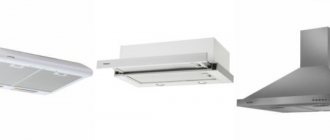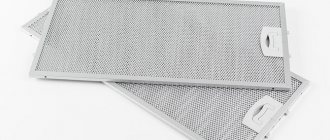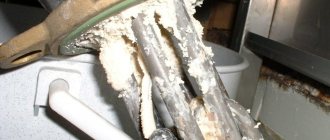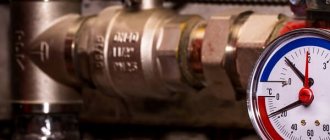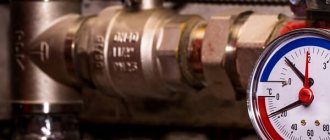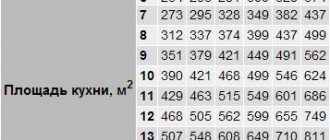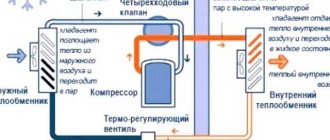Cooking is a daily concern for most housewives. If you don't equip your kitchen with the necessary equipment, wallpaper, curtains and furniture will smell like cakes and become sticky like superglue. That's why a kitchen hood is an indispensable attribute of every modern kitchen.
The main part of the device is a grease filter. It is equipped with any type of hood. By retaining fatty particles, it prevents its breakdown. Read on to learn about the types and designs of grease traps, the features of their selection and installation.
Types of grease filters
There are three types of kitchen hoods: flow-through, recirculating and combined. Depending on the type of device that captures vapors above the stove, it contains grease or grease + carbon filter elements .
For the normal operation of a flow-through exhaust device, one filter is enough - a grease filter, which takes the “first blow”, trapping fat particles and preventing them from penetrating inside the housing.
The sucked air in a flow-type hood, passing through the fatty element, is discharged through the air duct into the ventilation or passes through a deep cleaning filter and returns to the room already cleaned.
For your information. The grease trap element requires periodic cleaning. The sticky carbon layer is easily removed and washed.
Grease traps are disposable and reusable:
- A disposable grease trap mesh for kitchen hoods is used in cheap exhaust units once, until completely contaminated. It is made of synthetic material (sintepon, acrylic, non-woven fabric) and looks like a small rug. When it gets dirty, it is replaced with a new one. In such cases, washing is not enough: after water procedures, the effectiveness of the grease trap is reduced to almost zero.
- Reusable grease traps do not have an expiration date. This element is a kind of mesh made of aluminum, stainless steel or galvanized steel. Passing through such a filter element, polluted air is cleaned of greasy particles, leaving them on the mesh. It is easy to clean with detergents.
Grease traps for hoods differ in size, shape, materials of manufacture and efficiency. There are metal filters with different numbers of mesh layers.
Grease traps made of synthetic and organic fibers
Filter elements of the disposable category are made of polyester, acrylic, padding polyester or non-woven fabric with reinforcing sizing. For the most part, all fiber grease traps are disposable and the cheapest.
For your information. There are reusable models of acrylic grease traps. Once soiled, they are washed and reused. But sooner or later they still wear out. After each wash, their effectiveness gradually decreases. So they cannot be called full-fledged reusable filters.
It is not recommended to extend the service life of disposable grease traps with different types of cleaning , since cheap products are not designed for this. Washing will disrupt the structure of the fibers - the element will not be able to clean the air efficiently, and the likelihood of accelerated wear of the equipment will increase.
Metal grease filters
The metal cassette that comes with the exhaust unit is used throughout the entire service life of the hood . In fact, such an element is a frame with several thin mesh sheets of steel, foil or aluminum, which are responsible for primary air purification.
All cells of the mesh cassette are rotated at an angle for efficient operation of the filter . The more layers of mesh in the filter frame, the more often the direction of air entering the hood changes. Its streams are better cleaned of dirt, grease and combustion products.
Materials for making a reusable filter:
- foil;
- stainless steel;
- aluminum;
- galvanization.
In the case of foil, several layers of material are taken to make the filter element . To increase the productivity of the grease trap, perforation is used: holes in the material make the filter more efficient. The reusable foil element cleans the air efficiently, but has a short shelf life. In addition, such a filter is less durable compared to products made from other materials.
Steel grease traps will last as long as the hood itself, if not longer . Products made of stainless steel or galvanized are durable and safe, cope well with primary air purification and are not subject to corrosion.
Attention! Improper maintenance of a steel grease trap will result in rust.
The key disadvantage of a steel grease trap is its high cost . Therefore, such products are used on middle and premium class hoods.
The aluminum filter for the hood is effective, durable, durable . In the manufacture of some models, anodizing is used, so that the grease traps do not oxidize. The disadvantage of the aluminum element is its high price, especially for non-oxidizing models.
For ease of maintenance, manufacturers divide one cassette into 2-3 small ones . Small elements are convenient to remove and easier to clean.
Standard filter sizes
Reusable grease traps are durable and are used throughout the life of the hood . The dimensions of the elements responsible for air purification are indicated in the unit passport. If the hood is equipped with non-standard removable elements, you will have to order new ones from the manufacturer.
In the case of a disposable grease trap, the size issue is easily resolved. If there is no element on sale that matches the length and width parameters, you can buy a larger grease trap element and trim off the excess.
Is there a universal filter for charcoal hoods?
Today, universal carbon elements are quite popular, which can be used in almost all types of hoods in recirculation mode, that is, when there is no connection to ventilation.
Many people buy universal carbon filters for Elikor hoods made of non-woven fabric - polyester. The fabric is impregnated with activated carbon and absorbs odors and fat well. Filters from this manufacturer are affordable and suitable in cases where the hood is not used often.
VIDEO INSTRUCTIONS » alt=»»>
Which is better, a charcoal or grease filter for a hood?
Often, air exhaust hoods make do with only one filter – a grease filter, but for complete air purification it is still recommended to install a carbon one. How are they different from each other?
The fatty one performs rough cleaning and is designed to trap large particles of fat and soot that can damage the motor blades. The fatty element also protects the inner walls from oil vapors. Absorbs up to 96% of fat particles and unpleasant odors.
Coal ones are intended for fine cleaning; it is no coincidence that they are called anti-odor or absorption. Absorbs gases, harmful impurities of steam, odors.
Fat disposables are made from synthetic fibers, for example, acrylic, padding polyester, non-woven fabric. Used in inexpensive hoods. They cannot be cleaned and therefore require replacement.
Reusable ones are made of metal and mesh foil - symmetrical or asymmetrical. For production, stainless steel or galvanized steel with a protective layer against oxidation is used. Reusable ones are more practical; they are easy to wash by hand or in the dishwasher. Used in more expensive hoods.
- Let's look at several models of grease filters on the market.
Lissant-yug produces cassette versions suitable for use at temperatures up to +70C. They are non-separable, made of galvanized or stainless steel with a thickness of 0.5 mm. The filter element has five plates.
Manufacturer Roven offers customers a one-piece prefabricated structure made of stainless steel or galvanized steel that can withstand temperatures up to +80C. The filter element has three or five plates.
The manufacturer Titan produces options made of stainless steel with a thickness of 0.5 mm and a working environment temperature of up to +70C.
- Carbon filters are all disposable. The degree of filling may vary. The denser the coal, the lower the throughput. The shape can be round, rectangular, concave, flat. The body is usually made of plastic.
Buyers can order a carbon element of the desired size or purchase a standard one.
The range of hoods with a carbon element is very large. Thus, carbon filters for hoods are Hansa , Gorenje, Krona, Electrolux.
It is impossible to unequivocally answer the question which one is better, since it is necessary to use them simultaneously. In this case, high-quality and complete air purification will be ensured.
Where to buy a carbon filter for an exhaust hood - review of manufacturers
Let's consider different options for hoods with carbon purification systems from popular manufacturers.
- The Italian company produces hanging corner, wall-mounted and built-in models. They are characterized by low noise levels, ease of installation, and original design. Control can be either push-button or touch. The cost of equipment starts from 28,000 rubles, and the price of filters starts from 1,000 rubles.
- produces hoods with push-button and slider control systems. The equipment is silent and quite easy to install. The cost of the equipment is quite affordable and starts from 3,000 rubles. The cost of carbon filters starts from 400 rubles.
- Hansa brand products are deservedly considered one of the best on the market. The technology is economical, easy to use and inexpensive. Hansa filters are sold at prices starting from 2,900 rubles.
- produces built-in and wall-hung models equipped with a metal and carbon filter. They are characterized by economical energy consumption. For our own equipment, carbon elements are also presented, which are selected according to size for a specific model.
Design and principle of operation of a grease trap
Any universal-use grease filter looks like a cassette . It has a durable frame and mesh grids installed inside it. It is on them that grease settles when the engine sucks air into the hood body.
The grates are located at an angle and thus retain the largest possible amount of fat particles. The more layers of mesh, the more obstructions it creates for the suction flow. It is forced to change its direction many times, leaving the maximum amount of polluting particles on the element.
Some manufacturers divide the filter frame into several smaller cassettes . Such structural elements are easier to remove and wash.
Modern hoods come in three types:
- flow-through;
- recirculation;
- combined.
A flow hood sucks air into the housing and removes it outside the room through an air duct system.
The recirculation unit involves circulating air inside the kitchen . It has two elements - a grease trap and a deep cleaning filter. The air entering such a hood, passing through a filter system, is completely cleaned of combustion products, soot and grease and is returned back into the room through the openings in the housing.
A combined hood combines both of these cleaning methods , which can be used alternately.
The operating mode of the hood affects the function of the grease traps . In a flow-through hood, the air, passing through a coarse filter, is removed outside the kitchen. Large particles of sewage do not reach the elements of the exhaust unit (motor with fan).
In the design of a recirculation hood, complete air purification is a priority . The sucked air, leaving large particles on the grease trap grille, is cleaned of odors and other impurities using a deep cleaning filter. But here, too, the structural elements of the unit are not subject to contamination.
For your information. The grease trap not only performs primary air purification, but also protects everything that is located under the air cleaner housing from contamination.
In the absence of the fatty element, after just a few weeks of use, a sticky coating would form inside the hood, which is extremely difficult to get rid of. An increase in the load on the structure would lead to premature failure of the hood.
In recirculating hoods, the load on the grease trap increases . If you ignore cleaning it, large particles of fat will fall not only on the engine and fan, but will also coat the fine filter, which frees the air from odors and other small impurities. This will require frequent replacement of the cleaning element.
It can be useful:
About choosing a kitchen hood and installing an air duct
How to connect a kitchen hood to electricity
How to hide a hood in the kitchen
Types of kitchen hoods
The hood is an important element in ensuring normal ventilation in the kitchen. The speed at which odors are removed from the room depends on its effectiveness.
Carbon filters are a mandatory component not for all types of hoods, but only for recirculating ones, so let’s first remember what types of air purification devices there are in the kitchen.
According to the method of air flow, all hoods can be divided into three categories:
- flow-through;
- circulation (recirculation);
- combined.
Flow hoods are connected to the ventilation duct using a rigid or flexible air duct.
The air containing kitchen fumes enters the hood and then into the ventilation. Various types of flow-through devices are also equipped with filters, but their function is slightly different - to protect the motor from an aggressive environment.
Recirculation devices do not require air ducts.
The air flow in the circulation model comes from the stove into the housing, passes through 2 cleaning stages (2 types of filters - anti-grease and carbon), and then returns to the kitchen space.
Combined models have an additional recirculation function. That is, you can insert carbon filters and start the recirculation mode, or you can connect an air duct and use the flow function.
Filter installation and maintenance
The grease trap is located at the bottom of the exhaust unit and does not require complex maintenance . When the filter element mesh becomes clogged with dirt, it is removed, cleaned and replaced. The fat element is attached to the unit using special clamps, which are simply removed and installed.
Clean the grease trap in the following sequence:
- Disconnect the hood from the network.
- We find the lock of the filter element on the hood and the valve on it. We pull it towards ourselves, carefully supporting the grease trap.
- We remove the element and start cleaning it.
Adhered fat is cleaned with a special brush and a soap solution based on laundry soap , dishwashing gels and pastes, and laundry liquids.
Attention! Do not use washing powders to clean the grease filter. Abrasive detergents or baking soda will scratch the metal. Aluminum mesh cannot be washed with acidic or alkaline compounds.
After cleaning by any means, rinse the filter well under running water . Reinstall the element only after complete drying. It is recommended to dry the grease trap mesh at room temperature, away from sunlight. Installing a wet filter in the hood will lead to corrosion.
Disposable filters cannot be cleaned . If the grease trap fails, it is removed and thrown away, and a new element is installed in its place.
The need to clean or replace the filter is indicated by a special indicator on the hood body.
1 Purpose and types of filters, differences and prices
There is a wide variety of kitchen hoods. Each hood can be equipped with two types of filters:
Coarse cleaning includes grease filters that trap fumes and soot, as well as small particles. Their main purpose is to protect the internal parts, the walls of the air duct and the hood itself from grease and soot.
Grease filters can be either disposable or reusable. Disposable ones are made of acrylic and non-woven fabric. Reusable grease filters are made of steel and aluminum.
There are several types of grease filters on sale:
- The acrylic filter is simple and reliable to maintain. You can buy it at a price of 93 rubles;
- Paper filter - it consists of non-woven fabric, disposable. You can purchase it at a price of 255 rubles;
- Aluminum filter – reusable, easy to clean, made of perforated aluminum. Requires very careful care. Its price starts from 1,100 rubles;
Step-by-step installation of a carbon filter
It is recommended to wash or replace the grease filter for the hood on time. If this is not done, the load on the hood motor may increase and, as a result, its performance will decrease. Many grease filters have a replacement indicator, making it easy for you to know when the filter needs to be replaced.
Which is better to use: reusable or disposable grease filter
Any grease trap has its advantages and disadvantages . Let's look at the pros and cons of each variety in the table.
| Reusable filter | Disposable item | |
| Advantages |
|
|
| Flaws |
|
|
If you have neither the time nor the desire to regularly clean the cassettes from dirt , use disposable filters. To save money, it is better to purchase a reusable one.
Carbon filters
Carbon filters – for finer cleaning. Because Since the filtered air is fed back into the room, it must be cleaned more thoroughly. This is precisely what a carbon filter is used for, which is also called absorption (due to its properties) and anti-odor. This is quite logical, because it very effectively cleans the air of harmful impurities and various odors, including tasty and pleasant ones.
It is located behind the grease filter, and the air, after passing through the grease filter, passes through the carbon one. Those small substances that passed through the grease filter remain on it. Here the main element is activated carbon, which is an absorbent. It perfectly retains impurities in the air.
Carbon filters come in different filling densities. The filling increases as the hood is used, and the more the filter is filled, the worse its throughput. Consequently, the performance of the hood decreases. Therefore, they need to be changed frequently as they are filled. Apparently, if the filter is full, it will immediately become noticeable.
In general, carbon filters are disposable, and they are changed approximately once every 3-4 months. Some hoods can independently detect the filling of the filter and inform the user about the need to replace it using a sound signal.
Please rate the article:
Join on Telegram
Guidelines for the right choice
The main criterion for choosing a filter is its size and type . If you don't want or have time to constantly wash the sticky grill, use disposable fiber-based filters.
Keep in mind. Inexpensive disposable grease filters will be practical and effective only for small built-in hoods with low power. If the kitchen is used constantly, such filters are simply unprofitable.
A reusable foil filter, besides saving money, has no other advantages . The product is not very durable, so after several cleanings it will have to be thrown away.
The most durable and high-quality grease trap is made of steel or aluminum . The product costs an order of magnitude more, but is guaranteed to last as long as the hood itself, or even more.
Also pay attention to the number of mesh layers . Choose a filter consisting of several elements. A small cassette is easier to remove and wash than a huge panel.
